Silver nanoparticles immobilized on thin film composite polyamide membrane: characterization, nanofiltration, antifouling properties
Abstract
Microbial biofouling is one of the major obstacles for reaching the ultimate goal of realizing a high permeability over a prolonged period of nanofiltration operation. In this study, the hybrid nanocomposite membranes consisting of silver (Ag) nanoparticles with antibiofouling capability on microorganism and polyamide (PA) were prepared by in situ interfacial polymerization and characterized by X-ray photoelectron spectroscopy (XPS) and scanning electron microscope (SEM). The hybrid membranes were shown to possess the dramatic antibiofouling effect on Pseudomonas. In addition, Ag nanocomposite membranes had little influence on the performances of the membrane such as on water flux and salt rejection. SEM analysis results showed that all Pseudomonas were dead on the PA/Ag nanocomposite membrane, indicating the effectiveness of silver nanoparticles. This investigation offers a strong potential for possible use as a new type of antibiofouling membrane. Copyright © 2007 John Wiley & Sons, Ltd.




